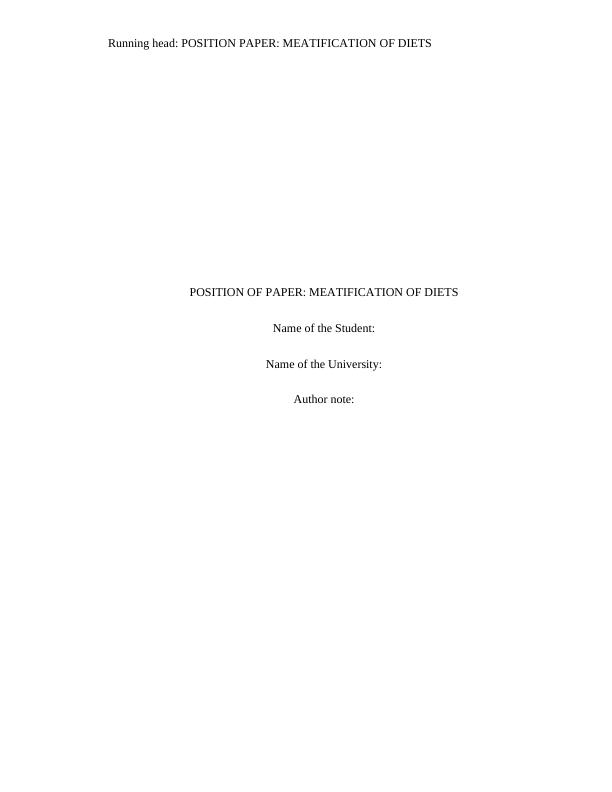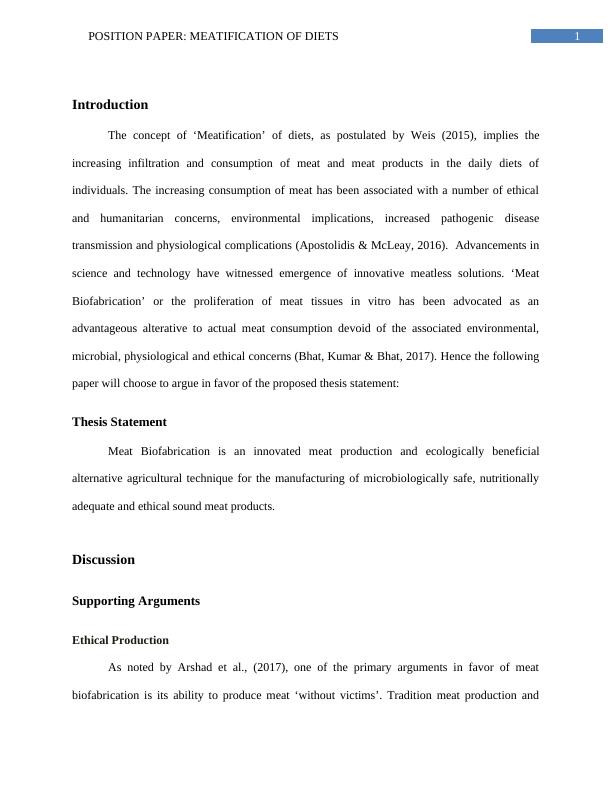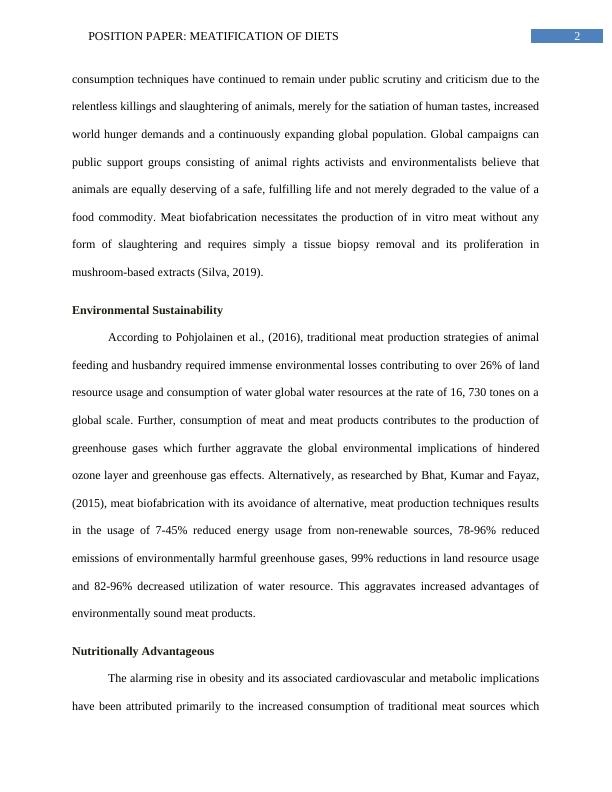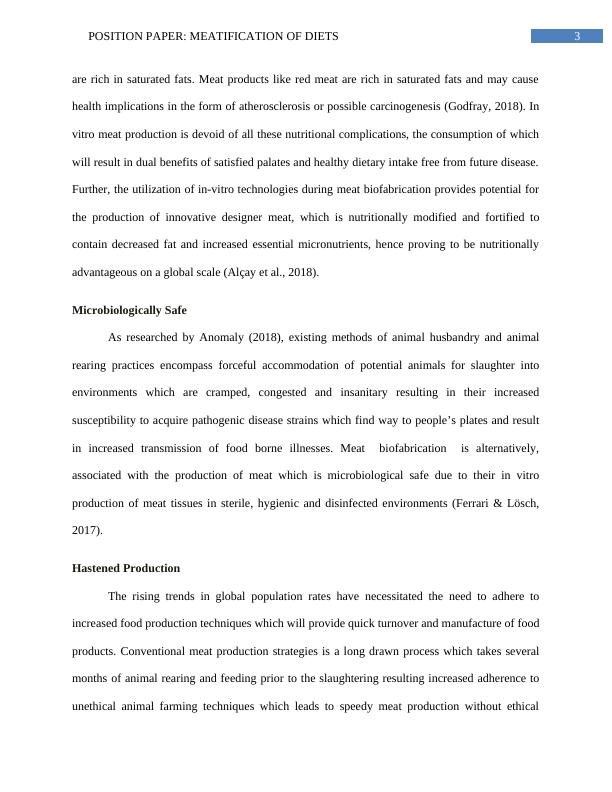Position Paper: Meatification of Diets
Added on 2023-04-21
15 Pages3859 Words195 Views
Running head: POSITION PAPER: MEATIFICATION OF DIETS
POSITION OF PAPER: MEATIFICATION OF DIETS
Name of the Student:
Name of the University:
Author note:
POSITION OF PAPER: MEATIFICATION OF DIETS
Name of the Student:
Name of the University:
Author note:

1POSITION PAPER: MEATIFICATION OF DIETS
Introduction
The concept of ‘Meatification’ of diets, as postulated by Weis (2015), implies the
increasing infiltration and consumption of meat and meat products in the daily diets of
individuals. The increasing consumption of meat has been associated with a number of ethical
and humanitarian concerns, environmental implications, increased pathogenic disease
transmission and physiological complications (Apostolidis & McLeay, 2016). Advancements in
science and technology have witnessed emergence of innovative meatless solutions. ‘Meat
Biofabrication’ or the proliferation of meat tissues in vitro has been advocated as an
advantageous alterative to actual meat consumption devoid of the associated environmental,
microbial, physiological and ethical concerns (Bhat, Kumar & Bhat, 2017). Hence the following
paper will choose to argue in favor of the proposed thesis statement:
Thesis Statement
Meat Biofabrication is an innovated meat production and ecologically beneficial
alternative agricultural technique for the manufacturing of microbiologically safe, nutritionally
adequate and ethical sound meat products.
Discussion
Supporting Arguments
Ethical Production
As noted by Arshad et al., (2017), one of the primary arguments in favor of meat
biofabrication is its ability to produce meat ‘without victims’. Tradition meat production and
Introduction
The concept of ‘Meatification’ of diets, as postulated by Weis (2015), implies the
increasing infiltration and consumption of meat and meat products in the daily diets of
individuals. The increasing consumption of meat has been associated with a number of ethical
and humanitarian concerns, environmental implications, increased pathogenic disease
transmission and physiological complications (Apostolidis & McLeay, 2016). Advancements in
science and technology have witnessed emergence of innovative meatless solutions. ‘Meat
Biofabrication’ or the proliferation of meat tissues in vitro has been advocated as an
advantageous alterative to actual meat consumption devoid of the associated environmental,
microbial, physiological and ethical concerns (Bhat, Kumar & Bhat, 2017). Hence the following
paper will choose to argue in favor of the proposed thesis statement:
Thesis Statement
Meat Biofabrication is an innovated meat production and ecologically beneficial
alternative agricultural technique for the manufacturing of microbiologically safe, nutritionally
adequate and ethical sound meat products.
Discussion
Supporting Arguments
Ethical Production
As noted by Arshad et al., (2017), one of the primary arguments in favor of meat
biofabrication is its ability to produce meat ‘without victims’. Tradition meat production and

2POSITION PAPER: MEATIFICATION OF DIETS
consumption techniques have continued to remain under public scrutiny and criticism due to the
relentless killings and slaughtering of animals, merely for the satiation of human tastes, increased
world hunger demands and a continuously expanding global population. Global campaigns can
public support groups consisting of animal rights activists and environmentalists believe that
animals are equally deserving of a safe, fulfilling life and not merely degraded to the value of a
food commodity. Meat biofabrication necessitates the production of in vitro meat without any
form of slaughtering and requires simply a tissue biopsy removal and its proliferation in
mushroom-based extracts (Silva, 2019).
Environmental Sustainability
According to Pohjolainen et al., (2016), traditional meat production strategies of animal
feeding and husbandry required immense environmental losses contributing to over 26% of land
resource usage and consumption of water global water resources at the rate of 16, 730 tones on a
global scale. Further, consumption of meat and meat products contributes to the production of
greenhouse gases which further aggravate the global environmental implications of hindered
ozone layer and greenhouse gas effects. Alternatively, as researched by Bhat, Kumar and Fayaz,
(2015), meat biofabrication with its avoidance of alternative, meat production techniques results
in the usage of 7-45% reduced energy usage from non-renewable sources, 78-96% reduced
emissions of environmentally harmful greenhouse gases, 99% reductions in land resource usage
and 82-96% decreased utilization of water resource. This aggravates increased advantages of
environmentally sound meat products.
Nutritionally Advantageous
The alarming rise in obesity and its associated cardiovascular and metabolic implications
have been attributed primarily to the increased consumption of traditional meat sources which
consumption techniques have continued to remain under public scrutiny and criticism due to the
relentless killings and slaughtering of animals, merely for the satiation of human tastes, increased
world hunger demands and a continuously expanding global population. Global campaigns can
public support groups consisting of animal rights activists and environmentalists believe that
animals are equally deserving of a safe, fulfilling life and not merely degraded to the value of a
food commodity. Meat biofabrication necessitates the production of in vitro meat without any
form of slaughtering and requires simply a tissue biopsy removal and its proliferation in
mushroom-based extracts (Silva, 2019).
Environmental Sustainability
According to Pohjolainen et al., (2016), traditional meat production strategies of animal
feeding and husbandry required immense environmental losses contributing to over 26% of land
resource usage and consumption of water global water resources at the rate of 16, 730 tones on a
global scale. Further, consumption of meat and meat products contributes to the production of
greenhouse gases which further aggravate the global environmental implications of hindered
ozone layer and greenhouse gas effects. Alternatively, as researched by Bhat, Kumar and Fayaz,
(2015), meat biofabrication with its avoidance of alternative, meat production techniques results
in the usage of 7-45% reduced energy usage from non-renewable sources, 78-96% reduced
emissions of environmentally harmful greenhouse gases, 99% reductions in land resource usage
and 82-96% decreased utilization of water resource. This aggravates increased advantages of
environmentally sound meat products.
Nutritionally Advantageous
The alarming rise in obesity and its associated cardiovascular and metabolic implications
have been attributed primarily to the increased consumption of traditional meat sources which

3POSITION PAPER: MEATIFICATION OF DIETS
are rich in saturated fats. Meat products like red meat are rich in saturated fats and may cause
health implications in the form of atherosclerosis or possible carcinogenesis (Godfray, 2018). In
vitro meat production is devoid of all these nutritional complications, the consumption of which
will result in dual benefits of satisfied palates and healthy dietary intake free from future disease.
Further, the utilization of in-vitro technologies during meat biofabrication provides potential for
the production of innovative designer meat, which is nutritionally modified and fortified to
contain decreased fat and increased essential micronutrients, hence proving to be nutritionally
advantageous on a global scale (Alçay et al., 2018).
Microbiologically Safe
As researched by Anomaly (2018), existing methods of animal husbandry and animal
rearing practices encompass forceful accommodation of potential animals for slaughter into
environments which are cramped, congested and insanitary resulting in their increased
susceptibility to acquire pathogenic disease strains which find way to people’s plates and result
in increased transmission of food borne illnesses. Meat biofabrication is alternatively,
associated with the production of meat which is microbiological safe due to their in vitro
production of meat tissues in sterile, hygienic and disinfected environments (Ferrari & Lösch,
2017).
Hastened Production
The rising trends in global population rates have necessitated the need to adhere to
increased food production techniques which will provide quick turnover and manufacture of food
products. Conventional meat production strategies is a long drawn process which takes several
months of animal rearing and feeding prior to the slaughtering resulting increased adherence to
unethical animal farming techniques which leads to speedy meat production without ethical
are rich in saturated fats. Meat products like red meat are rich in saturated fats and may cause
health implications in the form of atherosclerosis or possible carcinogenesis (Godfray, 2018). In
vitro meat production is devoid of all these nutritional complications, the consumption of which
will result in dual benefits of satisfied palates and healthy dietary intake free from future disease.
Further, the utilization of in-vitro technologies during meat biofabrication provides potential for
the production of innovative designer meat, which is nutritionally modified and fortified to
contain decreased fat and increased essential micronutrients, hence proving to be nutritionally
advantageous on a global scale (Alçay et al., 2018).
Microbiologically Safe
As researched by Anomaly (2018), existing methods of animal husbandry and animal
rearing practices encompass forceful accommodation of potential animals for slaughter into
environments which are cramped, congested and insanitary resulting in their increased
susceptibility to acquire pathogenic disease strains which find way to people’s plates and result
in increased transmission of food borne illnesses. Meat biofabrication is alternatively,
associated with the production of meat which is microbiological safe due to their in vitro
production of meat tissues in sterile, hygienic and disinfected environments (Ferrari & Lösch,
2017).
Hastened Production
The rising trends in global population rates have necessitated the need to adhere to
increased food production techniques which will provide quick turnover and manufacture of food
products. Conventional meat production strategies is a long drawn process which takes several
months of animal rearing and feeding prior to the slaughtering resulting increased adherence to
unethical animal farming techniques which leads to speedy meat production without ethical

End of preview
Want to access all the pages? Upload your documents or become a member.
Related Documents
Ecological and sustainable aspects of animal productionlg...
|6
|1300
|279